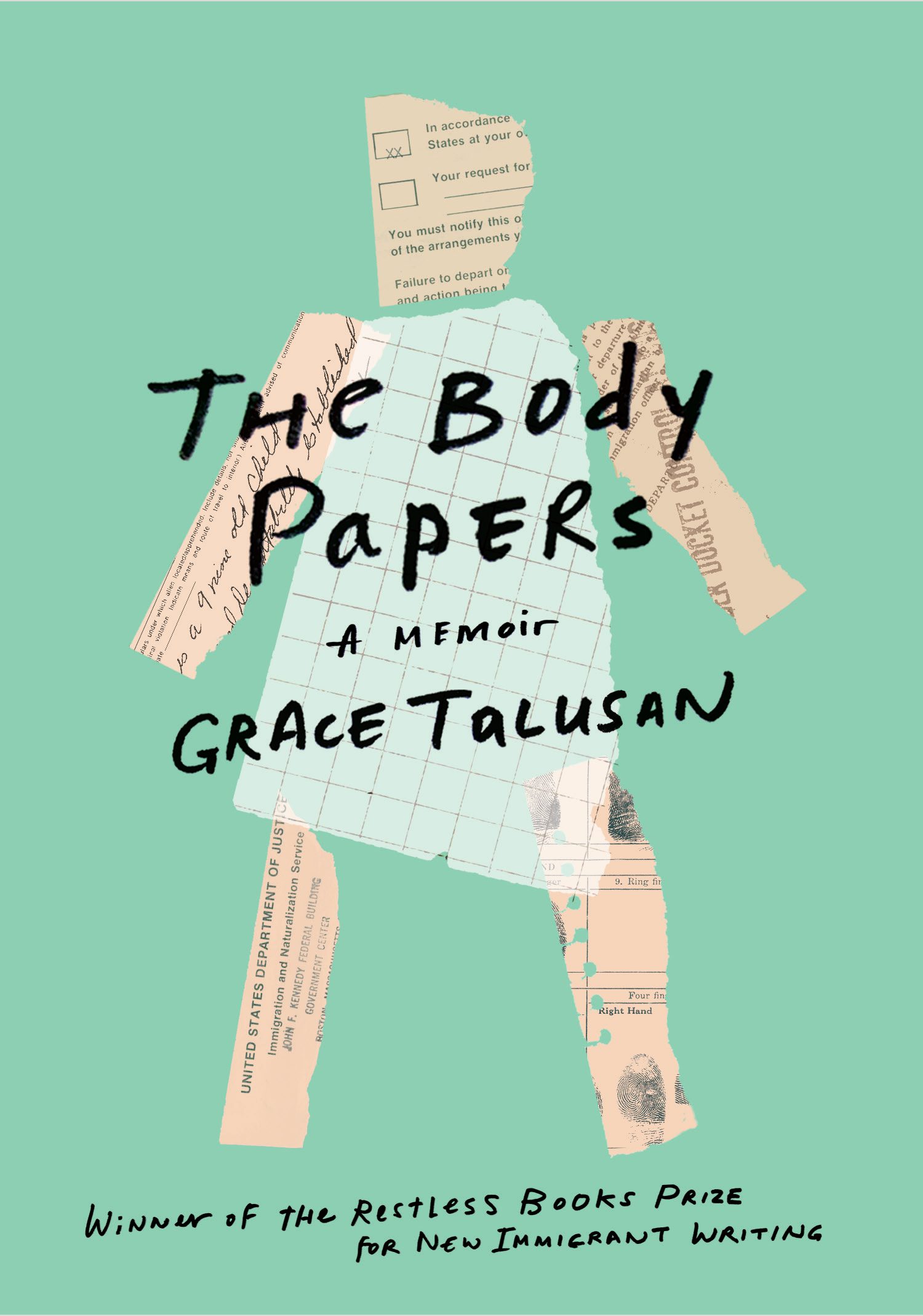
Grace Talusan’s The Body Papers is a memoir that begins in the Philippines, Talusan’s home until she was three. Now as an adult, she is a Fulbright scholar, and a foreigner in her home country. The Body Papers begins as a rediscovery of the new identity she has in this place that defines her, but it’s been a long journey to return to the place she was born.
For most of The Body Papers, Talusan traces the life she’s lived in New England, weaving together the stories of her family’s shifting American/Filipino identity, the confusing racism she encountered in her majority-white suburban town, the sudden awareness of her status as undocumented, the sexual abuse she endured for a painfully long period of her childhood, and the hereditary illnesses that claimed Grace, her family members, and pieces of their bodies.
Throughout The Body Papers, Talusan uses documents and photographs to illustrate the ways identity can be both evidenced and uncertain. This gorgeous memoir proves how impossible it is to separate out the myriad threads of influence that make up the singular individual.
***
The Rumpus: The Body Papers is a memoir that contains documents: photographs of you and your family, legal documents related to your citizenship, hospital records documenting things that have happened to your body, and others. You must have had so many documents to choose from. How did you decide what to include and what to leave out? And how did you hope these documents would help tell your story?
Grace Talusan: I suppose they offer a kind of validation and support for my memory. Memoir is writing based on memory, but I found that my memory was incomplete. I mostly wrote these pieces based on memory, but during the revision process, I studied the images and documents to add another layer of development to the writing. I found that there were conflicts between my memory and the documents. For example, the story I was told by my parents and I told myself and everyone else, is that I came to the United States at age three. I also had clear memories of arriving in the US in the middle of a snowstorm in Chicago. And yet, the documents that arrived from the FOIA request stated very clearly that I arrived in the US at age two in the middle of summer. So perhaps my memory starts at age three in the winter, but this memory is not fact.
For those who are interested in writing or making work inspired by their life experiences, I highly recommend bringing in research and using images and documents. There is so much richness there and material to respond to. To me, the tensions and conflicts between our memory and fact are so interesting. What are the stories we tell ourselves and why? And what happens when that story is challenged by fact? Does this change our relationship to the story, or do we try to justify our version of the thing so we can keep our version intact?
The memoir started out as essays, some as short as two pages, and I may have written a few of the pieces directly in response to a photograph or a document, but it wasn’t until I began to take these pieces and assemble them into a book-length manuscript that I began to weave the documents more deliberately between sections. I had some documents and photographs already in my possession, but once I started digging, I accumulated more and more. Very late in the book editing process, just last summer, I received about a hundred pages from the FOIA request I did on my immigration records.
I also started going through the hundreds and hundreds of slides my father had taken of my childhood. He switched over to prints when I was a pre-teen and collected them in physical photo albums with plastic pages. I rarely looked at those photo albums even though they were in a bookshelf in the living room all these years. The slides took a lot more effort to look at.
When I was a child, once a year or so, my father would set up the projector and screen and as a family, we would look at the slides and short films my father made on his Super-8, but that stopped before I was in high school. So many of these slides that ended up in the book, I had never seen before. In order to look at these slides, I had to order a special bulb for the slide projector. Thank goodness my father never throws anything away and he still had the slide projector.
I projected the slides onto my wall and the images were almost life-size. There was so much detail, it was painful at times. I could see the expression on my face. I was so moved by what I saw. I had to write about it and added new material to the book.
What became the final version of the book is very different from the manuscript I first submitted. Responding to documents and images as they came in, even very late in the revision process, is part of what changed the manuscript. All the way to the very end of the production process, even after galleys, we made changes to the documents and images. My editor, Nathan Rostron, and other folks on the Restless Books team, as well as friends I consulted, all informed the choices I made about which documents and images to use and which to leave out. I deliberated a lot about which images to use, especially ones of myself as a child. I decided not to use photos of my siblings past a certain age. The thought process I went through I regards to deciding which documents and images to use were similar to how I thought about what to include and exclude in the memoir. I let myself write about anything and everything, but once I was aware this material would be published, I went through a different process about what I wanted to be public and what I wanted to be private.
Rumpus: The memoirist is always tasked with deciding how much to guide the reader to interpret the events from their life. Throughout most of The Body Papers, you articulate, from your adult point of view, both how you felt about events then and what you understand about them now. One exception was the section about the animals in your family’s life. There are a few particularly brutal scenes involving family pets. These are heavy with metaphor, but these scenes are often left to the reader to interpret (yes, I’m thinking of the hamster scene). What was your motivation in leaving these very vivid childhood scenes up to reader interpretation? And how important was it for you to clarify your emotional experience throughout the memoir, rather than, in the scene-driven memoir style of Jeanette Walls or Jerald Walker, leaving almost everything up to the reader’s interpretation?
Talusan: I initially wrote that section a decade ago in response to reading Jonathan Safran Foer’s Eating Animals. I have also never recovered from seeing the Goya painting, “Saturn devouring one of his sons.” I came across the painting unexpectedly wandering the Prado when I was in my twenties and stood in front of it for what a long, long time. Last summer, I returned to Madrid and visited the painting again. It was like reuniting with an old friend. I know that’s an incongruous thing to observe about a brutal, horrific painting, but that painting makes me feel seen.
I started out writing as a fiction writer and some of what fascinates me in fiction is that all the characters are heroes in their own lives and have their own interpretations of events. I have to choose the primary character that I’m going to focus on in the story, but I want to leave room for the reader to make their own interpretation of the scenes. In my nonfiction, I want readers to have a similar reading experience. I imagine that each reader will bring their unique perspectives to the scenes and that’s interesting to me.
Because I wrote the pieces that became the book over many years, my feelings about these events have shifted, changed, deepened, and become more nuanced over time. I wanted to try to capture that complexity. I don’t mean to say that I don’t have an opinion about some of these experiences, which to me are clearly damaging ones. But given that I am writing mostly about humans, I wanted to try and humanize folks as much as possible. This doesn’t mean I excuse their behavior, but I wanted to try and understand. I can’t say that I do, even after all this. But I tried to and that seemed important.
Rumpus: The idea of intersectionality is paramount in this book, and this book is about so many things. Family identity, coming of age as a person of color in white suburbia, sexual abuse, hereditary illness, body image, immigration, and a portrait of the Philippines, to name a few. This is a lot to take on in one memoir, but the truth is that the reader cannot understand, for example, how your family—both in the US and in the Philippines—reacted to the disclosure of your sexual abuse without also understanding family structures and how they differ between cultures. When you began writing this book, did you know you wanted to try to tie all these themes together, or did you have a more specific idea that became a vortex for the larger, more complete story of your life?
Talusan: For me, as an immigrant, as a woman, as a non-Black person of color, and other identities, I have experienced the consequences of racism, sexism, and anti-immigrant rhetoric and policies, but I know that there are ways that my identity has afforded me privileges and benefits in this society. When I was writing this book, I wanted to write about the different parts of me and experiences that I’ve had that I don’t talk about in everyday conversation. I was moved to write the unspeakable and unsayable. In that sense, they are connected.
When I started writing what became this book, I didn’t think of it as a book, but as pieces or essays about all these things that I could not and did not talk about. I tried to push myself to get at what something was really like instead of what I wanted it to be or thought it should be to communicate a version of me that I wanted people to know. This is more the version I don’t want folks to know, that I’m too embarrassed or ashamed to talk about. Would people still like me? And why do I care so much about others’ approval? And even with that challenge, to write what I cannot speak, there are still ways I held back in the book.
***
Photograph of Grace Talusan © Alonso Nichols.





